Biomechanical Analysis of Hip Joint Arthroplasties using CT-Image Based Finite Element Method
Mitsugu Todo*
Research Institute for Applied Mechanics, Kyushu University, Kasuga, Japan
*Corresponding Author: Dr. Mitsugu Todo, Research Institute for Applied Mechanics, Kyushu University, 6-1 Kasuga-koen, Kasuga 816-8580, Japan
Received: 24 May 2018; Accepted: 05 June 2018; Published: 11 June 2018
Article Information
Citation: Mitsugu Todo. Biomechanical Analysis of Hip Joint Arthroplasties using CT-Image Based Finite Element Method. Journal of Surgery and Research 1 (2018): 34-41.
View / Download Pdf Share at FacebookAbstract
In the present study, medical CT images were utilized to develop 3D-computational models of hip joints and femoral bones. The finite element analysis was then performed to characterize the biomechanical problems associated with the bone models. The FEA results clearly exhibited dramatic changes of stress and SED profiles due to osteoarthritis and hip arthroplasty. Furthermore, a damage modelling was also introduced into the FEA to characterize the fracture problems of femoral bone with prostheses under a downstairs step and sideways fall conditions. Micro-damage formations are well predicted in the vicinity of the prostheses for bone cases. It is thus confirmed that CT-FEA can be very useful to understand the biomechanical problems in the field of orthopaedics.
Keywords
Computed tomography, Finite element method, Bone mineral density, Osteoarthritis, Bone fracture
Computed tomography articles Computed tomography Research articles Computed tomography review articles Computed tomography PubMed articles Computed tomography PubMed Central articles Computed tomography 2023 articles Computed tomography 2024 articles Computed tomography Scopus articles Computed tomography impact factor journals Computed tomography Scopus journals Computed tomography PubMed journals Computed tomography medical journals Computed tomography free journals Computed tomography best journals Computed tomography top journals Computed tomography free medical journals Computed tomography famous journals Computed tomography Google Scholar indexed journals Finite element method articles Finite element method Research articles Finite element method review articles Finite element method PubMed articles Finite element method PubMed Central articles Finite element method 2023 articles Finite element method 2024 articles Finite element method Scopus articles Finite element method impact factor journals Finite element method Scopus journals Finite element method PubMed journals Finite element method medical journals Finite element method free journals Finite element method best journals Finite element method top journals Finite element method free medical journals Finite element method famous journals Finite element method Google Scholar indexed journals Bone mineral density articles Bone mineral density Research articles Bone mineral density review articles Bone mineral density PubMed articles Bone mineral density PubMed Central articles Bone mineral density 2023 articles Bone mineral density 2024 articles Bone mineral density Scopus articles Bone mineral density impact factor journals Bone mineral density Scopus journals Bone mineral density PubMed journals Bone mineral density medical journals Bone mineral density free journals Bone mineral density best journals Bone mineral density top journals Bone mineral density free medical journals Bone mineral density famous journals Bone mineral density Google Scholar indexed journals Osteoarthritis articles Osteoarthritis Research articles Osteoarthritis review articles Osteoarthritis PubMed articles Osteoarthritis PubMed Central articles Osteoarthritis 2023 articles Osteoarthritis 2024 articles Osteoarthritis Scopus articles Osteoarthritis impact factor journals Osteoarthritis Scopus journals Osteoarthritis PubMed journals Osteoarthritis medical journals Osteoarthritis free journals Osteoarthritis best journals Osteoarthritis top journals Osteoarthritis free medical journals Osteoarthritis famous journals Osteoarthritis Google Scholar indexed journals Bone fracture articles Bone fracture Research articles Bone fracture review articles Bone fracture PubMed articles Bone fracture PubMed Central articles Bone fracture 2023 articles Bone fracture 2024 articles Bone fracture Scopus articles Bone fracture impact factor journals Bone fracture Scopus journals Bone fracture PubMed journals Bone fracture medical journals Bone fracture free journals Bone fracture best journals Bone fracture top journals Bone fracture free medical journals Bone fracture famous journals Bone fracture Google Scholar indexed journals total hip arthroplasty articles total hip arthroplasty Research articles total hip arthroplasty review articles total hip arthroplasty PubMed articles total hip arthroplasty PubMed Central articles total hip arthroplasty 2023 articles total hip arthroplasty 2024 articles total hip arthroplasty Scopus articles total hip arthroplasty impact factor journals total hip arthroplasty Scopus journals total hip arthroplasty PubMed journals total hip arthroplasty medical journals total hip arthroplasty free journals total hip arthroplasty best journals total hip arthroplasty top journals total hip arthroplasty free medical journals total hip arthroplasty famous journals total hip arthroplasty Google Scholar indexed journals Osteotomy articles Osteotomy Research articles Osteotomy review articles Osteotomy PubMed articles Osteotomy PubMed Central articles Osteotomy 2023 articles Osteotomy 2024 articles Osteotomy Scopus articles Osteotomy impact factor journals Osteotomy Scopus journals Osteotomy PubMed journals Osteotomy medical journals Osteotomy free journals Osteotomy best journals Osteotomy top journals Osteotomy free medical journals Osteotomy famous journals Osteotomy Google Scholar indexed journals FEA code articles FEA code Research articles FEA code review articles FEA code PubMed articles FEA code PubMed Central articles FEA code 2023 articles FEA code 2024 articles FEA code Scopus articles FEA code impact factor journals FEA code Scopus journals FEA code PubMed journals FEA code medical journals FEA code free journals FEA code best journals FEA code top journals FEA code free medical journals FEA code famous journals FEA code Google Scholar indexed journals tensile fracture articles tensile fracture Research articles tensile fracture review articles tensile fracture PubMed articles tensile fracture PubMed Central articles tensile fracture 2023 articles tensile fracture 2024 articles tensile fracture Scopus articles tensile fracture impact factor journals tensile fracture Scopus journals tensile fracture PubMed journals tensile fracture medical journals tensile fracture free journals tensile fracture best journals tensile fracture top journals tensile fracture free medical journals tensile fracture famous journals tensile fracture Google Scholar indexed journals biomechanical problems articles biomechanical problems Research articles biomechanical problems review articles biomechanical problems PubMed articles biomechanical problems PubMed Central articles biomechanical problems 2023 articles biomechanical problems 2024 articles biomechanical problems Scopus articles biomechanical problems impact factor journals biomechanical problems Scopus journals biomechanical problems PubMed journals biomechanical problems medical journals biomechanical problems free journals biomechanical problems best journals biomechanical problems top journals biomechanical problems free medical journals biomechanical problems famous journals biomechanical problems Google Scholar indexed journals
Article Details
1. Introduction
Computed tomography (CT) scan makes use of X-ray images to produce cross-sectional images of specific areas of human body. These sliced images can be utilized to construct the 3D structure of the area by layering each images in the direction perpendicular to the slicing. For example, 3D structures of skeleton can be developed by selecting bone parts from the CT images. The intensity of each image is directly related to the bone mineral density (BMD) distribution and a bright region usually corresponds to a higher BMD. It has been established that a simple linear relationship can be assumed between the CT values (Hounsfield unit) and BMD; therefore, it is possible to easily estimate the BMD distribution on each image. Furthermore, it is also possible to construct a 3D computational model of the bone with BMD distribution for finite element analysis (FEA) [1, 2].
Such CT-image based EFA (CT-FEA) has widely been utilized to characterize biomechanical problems associated with orthopaedic [2-6] and dental sciences [7, 8], in which diseases related to bones are mainly treated. Bones mainly consist of organic and inorganic mineral components such as collagen and carbonate apatite. It has been believed that the apatite determines the stiffness and strength of the bone structures, and therefore, the bone mineral density (BMD) can be a controlling parameter in the biomechanical analysis of skeletal structures. Interactive problems between bone structures and metal implants have also been investigated by CT-FEA since such problems are strongly related to mismatching of elastic modulus between the material and bone tissue and/or stiffness between the implant and bone structure.
In this paper, two different biomechanical problems associated with hip arthroplasty are presented. One is biomechanical analysis of stress shielding, which is one of the most important mechanical problems associated with orthopaedic metal implants (Figure 1a). In this problem, bone tissue surrounding the metal implant such as a stem of hip prosthesis is gradually absorbed due to the mismatching of stiffness between the bone and stem. The reason is thought to be the reduction of mechanical stimulus to the bone due to the small deformation of stem with high stiffness. Another problem is fracture of bone associated with hip prostheses as shown in Figure 1b. CT-FEA was applied to analyse those two kinds of problems.
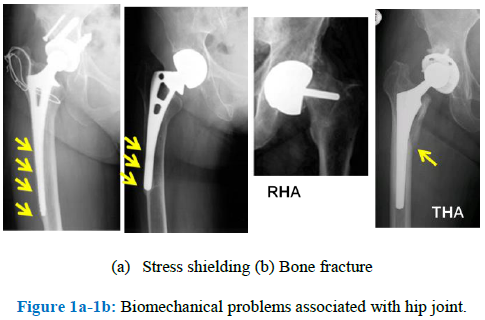
Figure 1:
2. Finite Element Analysis
2.1 Three dimensional modelling of hip joint
An example of 3D hip joint model constructed from CT images of 52 years old patient is shown in Figure 2. The CT images were provided by Kyushu University Hospital. This female patient has been suffered by osteoarthritis of right hip joint. The computational modelling was conducted by using Mechanical Finder software (RCCM, Inc.). Distribution of bone mineral densities (BMD) were estimated from CT values of each of the images by assuming a linear relation between the CT values and BMD. Then, the elastic modulus of a finite element was evaluated from the average value of BMD of the element on the basis of Keyak’s model [1]. The elastic modulus distributions of the right and left hip joints are shown in Figure 3. It is worth noting that inhomogeneous realistic distributions of modulus were clearly reproduced in the 3D finite element models.
A virtual model of total hip arthroplasty (THA) can be developed by using the current hip joint model and CAD images of hip prosthesis. Osteotomy was applied to the hip joint model so that the hip prosthesis can properly be inserted and placed into the femur and pelvis. The schematic procedure of the 3D THA modelling is shown in Figure 4a. A simple boundary condition corresponding to a stance situation was introduced into the THA model as shown in Figure 4b. Distributed load of 1800 N was applied to the top of the pelvis.
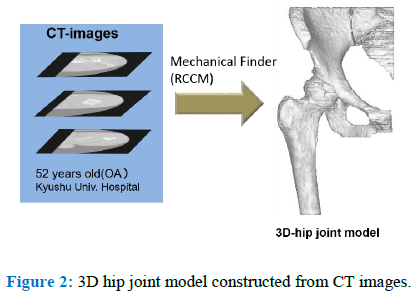
Figure 2:
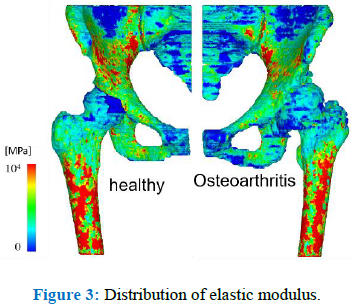
Figure 3:
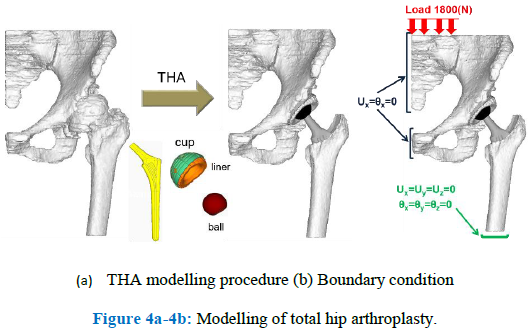
Figure 4:
In order to analyse bone fracture associated with hip arthroplasties, a whole femoral model was also developed from CT images of a 54 years old male. Resurface hip arthroplasty (RHA) and THA were then treated to the femoral model as shown in Figure 5. As the boundary conditions, two different situations such as downstairs step and sideway fall were assumed and simplified conditions were applied to the model as shown in Figure 6. A damage model was also introduced into the FEA code in order to predict bone fracture by damage accumulation. It was assumed that each of the finite elements could be damaged under both tensile and compressive situations. Under tensile condition, the bone tissue was assumed to be a linear elastic and brittle so that the maximum principal stress controlled the tensile fracture. The tensile fracture took place when the maximum principal stress reached its critical value. On the other hand, the bone tissue was assumed to be an elastic-plastic body under compression, and therefore, the equivalent stress controlled the yielding behaviour, while the compressive fracture occurred when the minimum principal strain reached its critical value. The elastic modulus of the tensile and compressive fractured elements was set to be the minimum value of the elastic moduli in the model.
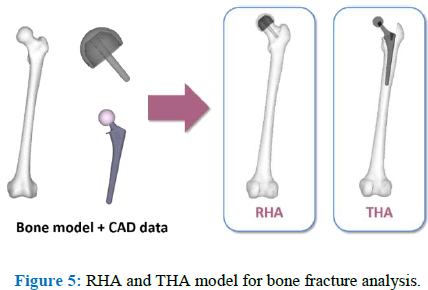
Figure 5:
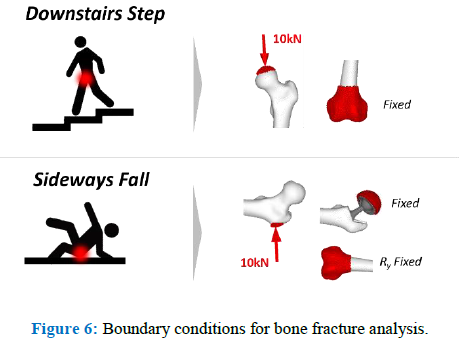
Figure 6:
3. Results and Discussion
3.1 Hip joint analysis
Distributions of the strain energy density (SED) on the cross-sectional areas of the normal, abnormal (OA) and THA femur are shown in Figure 7. It is seen that SED is severely concentrated in the neck of the OA femur due to severe deformation of the femoral head and neck. On the contrary, SED is extensively reduced in the THA femur as a result of stress shielding. The kind of SED reduction corresponds to the reduction of mechanical stimulus to the bone tissue, resulting in activating bone resorption behaviour and reduction of BMD. Such SED reduction is clearly shown in Figure 8a where SED is plotted along the line from the lesser trochanter to the lower edge of the femoral models. Drastic reduction of SED is observed in the THA femur, while severe SED concentration appears in the abnormal model. Such SED concentration may accelerate the OA and deformation of the femoral head and neck. Schematic illustration is presented in Figure 9. Old bone is resorved by osteoclasts and cavities are created. Then, osteoblasts try to create new bone tissue consisting of type I collagen and carbonate apatite crystals. Reduction of mechanical stimulus tends to break such balanced remodelling cycle.
In the field of biomaterials, it has been considered that one of the most effective ways to avoid the stress shielding is to reduce the elastic modulus of the stem material, Ti alloy. Currently, the modulus of Ti alloy has successfully been reduced up to around 50 GPa without sacrificing other mechanical properties. The effect of such modulus reduction on the SED distribution in the femur is shown in Figure 8b. SED effectively increased due to the reduction of modulus, suggesting improvement of mechanical stimulus.
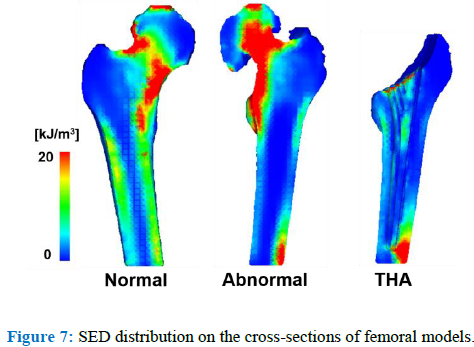
Figure 7:
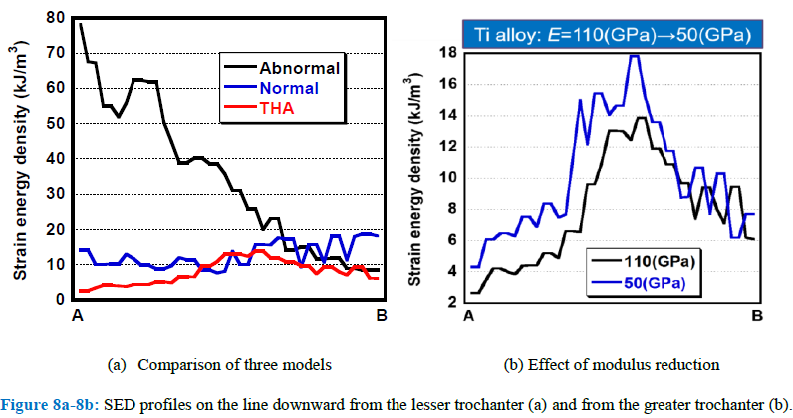
Figure 8:
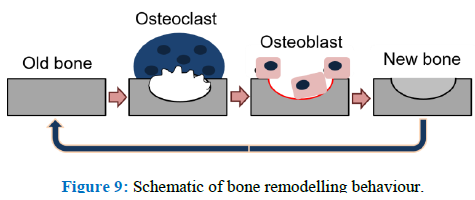
Figure 9:
3.2 Fracture analysis
Distribution of failure elements in the RHA and THA models under two different loading conditions are shown in Figure 10. Under the downstairs, the RHA model shows damage formation along the interface between the head and bone. Elemental damages are also observed in the vicinity of the stem. This damage accumulation may be related to loosening of the implant or fracture of femoral neck. In the THA model, damages are generated in the top region of bone close to the stem, suggesting that loosening of stem may occur due to such damage accumulation. Under the sideway falls, most of damages are generated in the great trochanter at which the load is applied directly. Furthermore, extensive damages are also observed in the femoral neck of the RHA model, suggesting that neck fracture can take place under the sideway falls condition.
The fracture loads of the RHA and THA models under the two conditions are compared with that of the intact bone model in Figure 11. Obviously, under the downstairs step, the fracture loads of the HA models are higher than that of the intact, indicating that the HAs tend to ease the risk of bone fracture. On the contrary, under the sideway falls, the fracture loads of the HA models become lower than that of the intact, suggesting that the fracture risk increases due to the HAs.
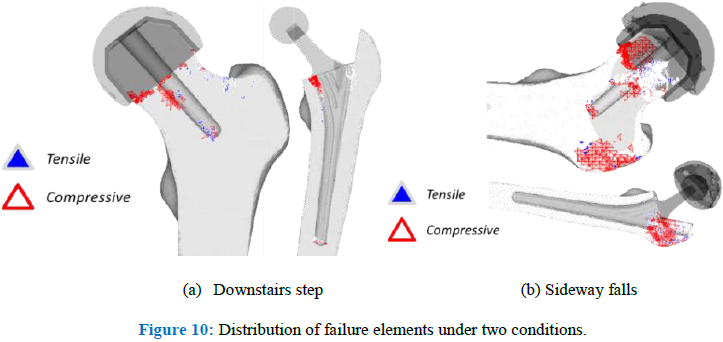
Figure 10:
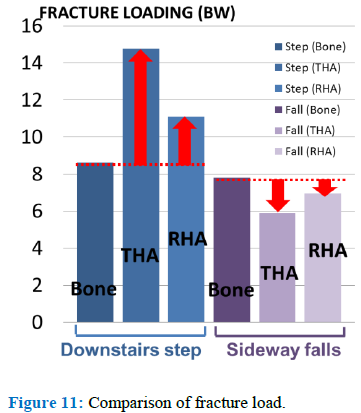
Figure 11:
4. Conclusions
CT-image based finite element analysis was applied to analyse the biomechanical problems associated with hip joint and hip arthroplasty. The results obtained are summarized as follows:
- Stress shielding effect in the vicinity of metal stem due to total hip arthroplasty can be reproduced as reduction of the strain energy density distribution.
- Stress shielding may be able to overcome due to increasing mechanical stimulus by reducing the elastic modulus of the metal stem.
- Fracture problems of bone and loosening of implants may be able to analyse CT-FEA with the damage model.
- CT-FEA is also useful to assess the fracture risk of bone.
References
- Keyak JH, Rossi SA, et al. Prediction of femoral fracture load using automated finite element modelling. Journal of Biomechanics 31 (1998): 125-133.
- Bessho M, Ohnishi I, et al. Prediction of proximal femur strength using a CT-based nonlinear finite element method: differences in predicted fracture load and site with changing load and boundary conditions. Bone 45 (2009): 226-231.
- Mazlan MH, Todo M, et al. Effect of cage insertion Orientation on stress profiles and subsidence phenomenon in posterior lumbar inerbody fusion. Journal of Medical and Bioengineering 5 (2016): 93-97.
- Mazlan MH, Todo M, et al. Biomechanical Effects of Balloon Kyphoplasty on Treated and adjacent non-treated vertebral bodies: Pre and Post-operative Evaluation. ARPN Journal of Engineering and Applied Sciences 10 (2015): 6197-6202.
- Abdullah AH, Todo M. Effects of hip arthroplasties on bone adaptation in lower limbs: A computational study. Journal of Bioscience and Medicines 3 (2015): 1-7.
- Abdullah AH, Todo M. Stress evaluation of lower limbs with hip osteoarthritis and hip arthroplasty. Journal of Medical and Bioengineering 4 (2015): 100-104.
- Arahira T, Todo M, et al. Assessment of Mechanical Stability and Safety for Fully Edentulous Maxilla with Dental Implants. Journal of Solid Mechanics and Materials Engineering 5 (2010): 526-538.
- Albogha MH, Kitahara T, Todo M, et al. Maximum principal strain as a criterion for prediction of orthodontic mini-implants failure in subject-specific finite element models. Angle Orthodontist 86 (2016): 24-31.


 Impact Factor: * 4.2
Impact Factor: * 4.2 Acceptance Rate: 72.62%
Acceptance Rate: 72.62%  Time to first decision: 10.4 days
Time to first decision: 10.4 days  Time from article received to acceptance: 2-3 weeks
Time from article received to acceptance: 2-3 weeks 